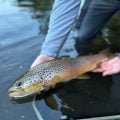How to Tie a Black & Tan Jig
Producer: Tim Flagler
“I call this little jig the Black & Tan because it’s, well, black and tan. It’s specifically designed for the low, clear water conditions we’ve been getting here in the East, in the fall, for the last few years. Small and subtle is the name of the game, with contrast and markings being the most prominent attractive qualities.
I recently changed the hook to a super cool-looking Fulling Mill 5125 in size 20. Although really short, it maintains a wide gap for more positive hook sets.
I’ll match the hook with a 3/32” black nickel slotted Tungsten bead. I’ve found plunger-style hackle pliers very helpful when it comes to getting the hook point stuffed into the small hole of the bead. After getting the hook firmly secured in the jaws of your tying vise, it’s important to make sure the bead is oriented correctly. You don’t want the squared off end of the slot pointing up. It’s the shorter, curved end of the slot that should be up.
For thread, I’ve loaded a bobbin with a spool of black UTC 70 Denier. Get the thread started at the back edge of the bead and, after taking a few wraps rearward, snip off the excess tag.
.02 lead-free round wire is used to add just a little bit of weight, but mainly to stabilize the bead behind the hook eye. Insert one end of the wire into the back end of the bead, on top of the hook shank. This will brace the bead against the back edge of the eye. Take thread wraps to secure the wire there. As you wrap rearward, rock the wire up and down to break it off, leaving a ramp down to the hook shank. Take a few more thread wraps to decrease the steepness of the ramp, then leave your thread at about the hook point.
Fibers from a medium Pardo Coq-de-Leon feather are used for the tail, because they’re very stiff, straight and exquisitely marked. Pull a half dozen or so down, perpendicular to the stem, then strip them free, while keeping their tips aligned. Measure to form a short tail, only about a hook shank in length. Transfer that measurement rearward to the start of the bend. Bring your tying scissors in, and using the back end of the wire as a guide, snip the butt ends of the fibers off square. Give your bobbin a counterclockwise spin so the first wrap of tying thread jumps rearward and catches those very butt ends. Pull up and towards you on the fibers so thread wraps will anchor them to the top of the shank, rather than push them to the far side. End with your thread back in front of the hook point.
Black extra-small Ultra wire is used to rib and segment the fly. You can get away with small, but it looks a little clunky. A 10” length will make numerous Black & Tan’s. Place one end of the wire on top of the hook shank and take thread wraps to secure it. Subsequent wraps should push the wire to the far side of the hook, which is desirable. Wrap back to the base of the tail. This time, end with your tying thread up near the back edge of the bead.
Spooled tan Antron yarn is used for the body of the fly. It provides a good amount of contrast to the black materials, and Antron is simply unrivaled in terms of shimmer and translucency. A 10” length will make numerous flies. You need very little, so pick up your bodkin and use it to split a single strand in half. Plunger-style hackle pliers are great for keeping track of the unused portion. While holding one end of the other half, place it on top of the hook shank and, once again, use the back end of the wire wraps as a guide for your scissors, and trim the uneven ends off square.
Give your bobbin a counterclockwise spin to catch the butt ends with the first wrap then, while pulling the Antron rearward and up, anchor it to the top of the hook shank with wraps of tying thread. Go all the way back to the base of the tail then end with your thread behind the bead. Start taking wraps with the Antron, smoothing it out as you go, almost like floss, to make a nice, even, thin coat over the entire body of the fly. When you reach your tying thread, use it to firmly anchor the Antron, then snip the excess off close.
Now, get hold of the black wire and start making open spiral wraps with it over top of the Antron. Because the wire’s so thin, it can be a bit challenging to make perfect, open spiral wraps, but this fly is so small, that close enough is just fine. At the back edge of the bead, anchor the wire with wraps of tying thread, brace the fly with your bobbin nozzle and helicopter the wire to break it off close.
Reach for your whip finish tool and use it to do a 4 or 5 turn whip finish, then seat the knot well and snip or cut your tying thread free. Try to keep the thread collar fairly small. A minimal amount of head cement or here, Sally Hansen Hard as Nails, applied to the black thread wraps and allowed to sink in and dry, will keep them from coming unraveled.
If low, clear, Fall conditions are giving you fits, you may want to try a Black & Tan. Sometimes small and subtle will absolutely out fish big and bold.and bold.”
How to Tie a Bird's Nest Sulphur Emerger
How to Tie a Black Bear Green Butt











